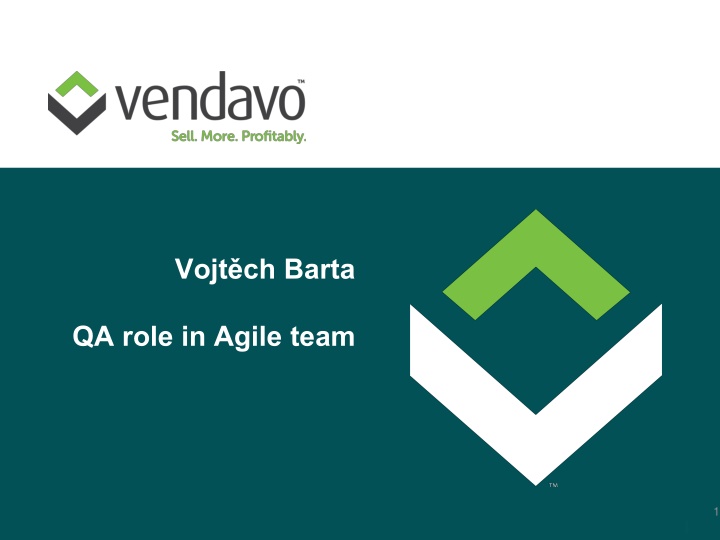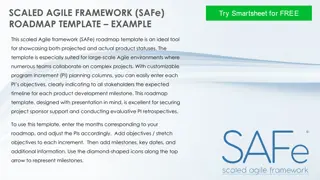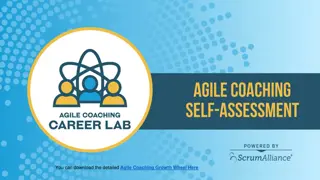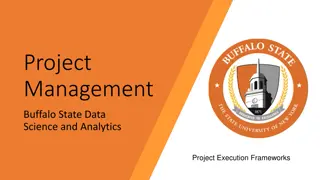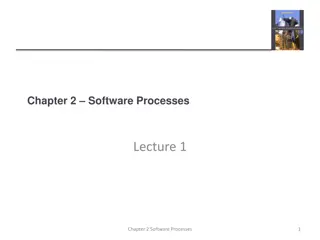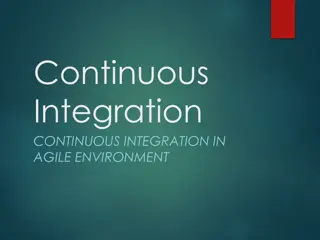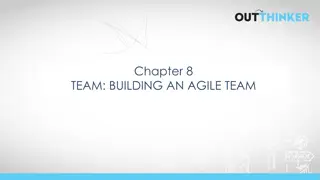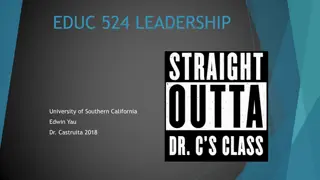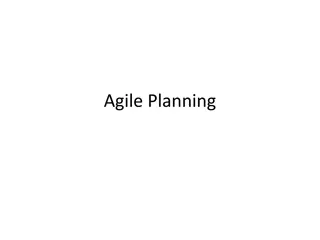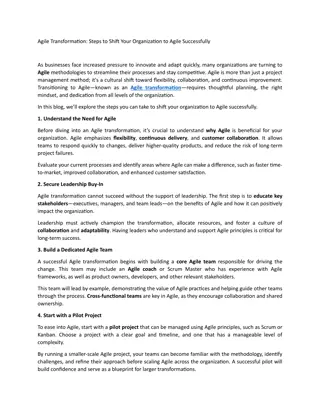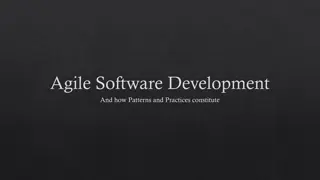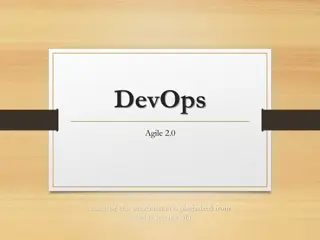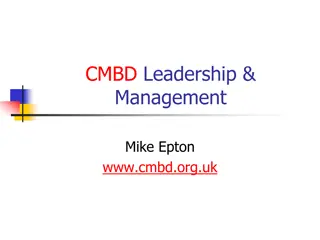Insights into QA Leadership and Agile Challenges
Vojtch Barta's role in leading QA teams in an Agile environment, addressing challenges in project initiation, stakeholder communication, and SOW understanding. Learn about defining quality, project vision, and the importance of stakeholder satisfaction
Download Presentation

Please find below an Image/Link to download the presentation.
The content on the website is provided AS IS for your information and personal use only. It may not be sold, licensed, or shared on other websites without obtaining consent from the author.If you encounter any issues during the download, it is possible that the publisher has removed the file from their server.
You are allowed to download the files provided on this website for personal or commercial use, subject to the condition that they are used lawfully. All files are the property of their respective owners.
The content on the website is provided AS IS for your information and personal use only. It may not be sold, licensed, or shared on other websites without obtaining consent from the author.
E N D
Presentation Transcript
Vojtch Barta QA role in Agile team 1
Vojtch Barta E-mail: bartavoj@gmail.com Twitter: @bartavoj Web: bartavoj.cz QA, Testing, Agile About 8 years Leading QA Team in Vendavo 2
What is quality? Quite a lot of definitions -> Choose or Build your own Four levels of quality Deliver according to requirements Deliver according correct requirements Deliver value according to correct requirements Deliver value according to correct requirements when all stakeholders are satisfied and happy Quality is Satisfaction of all stakeholders
Do I really do it this way? Of course not! It is a vision, target, something I aim for You need to know where you would like to be to go in correct direction Each project has own challenges It is about people!!!
Before project Our projects are based on SOW which defines a lot of things Problems starts here Our customers have different knowledge of Agile Different experience and expectations They do not understand process yet Lessons learned Never ever say Agile is easy for customer. It is not and they need to be prepared Make sure all stakeholders understands their responsibilities Find out where are you as soon as possible
SOW We have good SOW (not perfect) but Nobody cares to much about the most important chapters Methodology to be followed What does it mean to work in Sprints? What is a definition of done? What do we expect from customers? Everybody cares about Scope It is not understood as wish list Despite SOW is legal document it is hard to push to make to process real later in the project
Foundation Sprint Is kind off kick of Sprint(s) before real implementation starts Very good idea with clear Exit Criteria All stakeholders identified and understood Process of working agreed (Sprints, responsibilities, etc.) High level idea is clear Enough User Stories to start next Sprint (ideally for next two sprints to mitigate risk of PO to be bottleneck) Test Strategy Prepared, reviewed and agreed
Foundation Sprint - BUT We are not strict on Exit Criteria All stakeholders identified and understood Testing team on Customer team what are you talking about? Process of working agreed (Sprints, responsibilities, etc.) That is not how we understood SOW we do not like that High level idea is clear Enough User Stories to start next Sprint Even most important User Stories are vague, not clear, missing Acceptance Criteria, etc. Test Strategy Prepared, reviewed and agreed Testing is your stuff
QA Work in Foundation Sprint Process Help with negotiation Requirements Agree on the way how requirements should be captured to provide Enough information for Devs to Develop and Test For Testers to Test For PO to Accept For Customer to Accept Test strategy What we should do and why? Who is responsible for what? Preventing vs. Finding bugs
Sprint work 12
Sprint work Small waterfalls Sprint as Small waterfall There is no Test Phase in Agile!!!
Sprint work ensuring business understanding Grooming Regular whole team activity Go trough new / changed User Stories PO -> Team = business understanding sharing Team -> PO = quick feedback Achieve team agreement about requirements
Sprint work ensuring business understanding - BUT Grooming Regular whole team activity It is not regular Go trough new / changed User Stories There are not enough User Stories defined PO -> Team = business understanding sharing Devs do not not care Team -> PO = quick feedback Voiceless (sleeping) team
Sprint work ensuring business understanding Sizing When we are satisfied based on grooming Set a size as relative measure Achieve team agreement about complexity
Sprint work ensuring business understanding - BUT Sizing When we are satisfied based on grooming Set a size as relative measure What is the middle size Manager: I need to know it in hours Achieve team agreement about complexity
Sprint work planning as personal commitment Planning Break down US to Tasks Each task is estimated by the one who will do it At least one Dev and one QA task Agree who will test what (Dev vs. QA)
Sprint work planning as personal commitment - BUT Planning Break down US to Tasks Each task is estimated by the one who will do it Estimates are low Estimates are guess with buffer Somebody else provides estimates At least one Dev and one QA task Agree who will test what (Dev vs. QA) Why should Devs test?
Sprint Progress QA Touch Points Before Before development of Critical US starts QA + Dev Do we have same expectations? QA Dev This is how I will test it This is what I do expect from you to test What help do you need?
Sprint Progress QA Touch Points During Support Devs This is the highest priority for QAs Sometimes QA = Questions and answers QA should be capable to answer the most of the questions There is very close cooperation between QA and Dev on each task = know your developers Product Owner is usually busy with preparation of next sprint We do pair programming Dev + QA sometimes Senior QAs need to be able to understand code properly
Sprint Progress QA Touch Points During Test Case preparation Test Cases should have right level of details Steps are optional Supporting materials (excels, diagrams, mind maps) Are Identification of test flows and effective way how to test them Measure Are not Prove of testing Training materials Sometimes done even in advance in cooperation with Product Owner
Sprint Progress QA Touch Points During Automation There is no Agile success without Automation Not necessarily QA task Really dependent on project, architecture, etc.
Sprint Progress QA Touch Points After Handover to QA When development is finished (or more often) Dev QA This is how I implemented it = Demo This is how I tested it QA Dev Direct feedback Avoiding ping pong Reduce time of testing Testing Yes we test
Sprint Progress Internal Demo Good practice to have weekly Demo QAs are a good candidates to do it Present to the team what was done Devs to comment on others work QAs to get bigger picture Product Owner to validate
Demo to customer There have to be demo to customer be the end of each Sprint Actively seek for feedback Get acceptance if possible
Supporting customers Help them with regular testing Most of the US cannot be accepted on Demo Further Customer testing is required for Acceptance Customer are not test experts In our case they do not know our product Teach them, but do not do it instead of them During UAT Be onsite and help to solve problems quickly
Reporting What is the reason for reports To inform about something Target for different audience Do not do reports which nobody needs Make them easy
